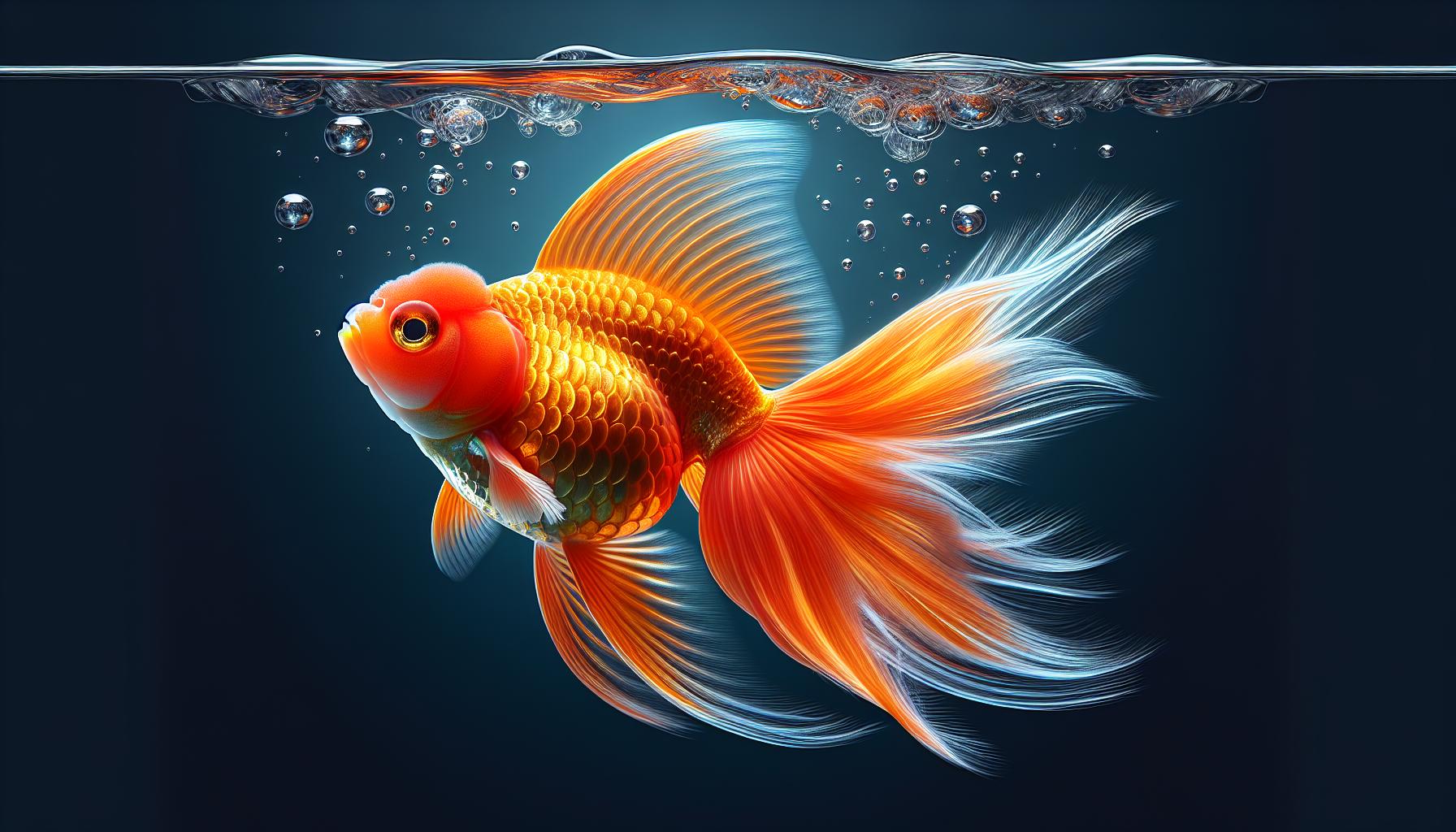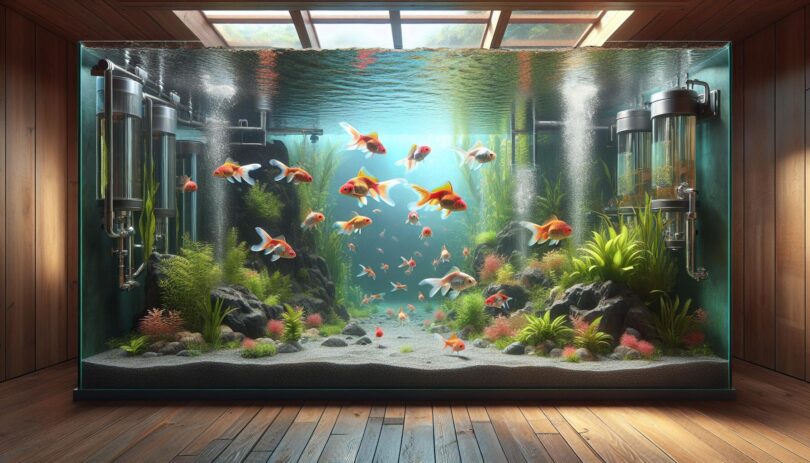Common goldfish might seem like a simple pet choice, but there’s a world of wonder beneath their golden scales. From their origins in ancient China to their status as a beloved household pet, these creatures have swum their way into the hearts of millions. I’ve always been fascinated by their vibrant colors and graceful movements, which make them a captivating subject for any fish enthusiast.
Their care might seem straightforward, but there’s a lot to learn about keeping common goldfish healthy and happy. Whether you’re a seasoned aquarist or just considering your first goldfish tank, understanding their needs is key to ensuring they thrive. Let’s dive into the fascinating world of common goldfish and discover what makes them such a popular choice for aquariums around the globe.
Key Takeaways
- Origins and Historical Significance: Common goldfish trace their origins back to ancient China over a thousand years ago, where they were selectively bred for their golden color from wild carp. Their journey from being symbols of good luck and fortune in China to becoming globally cherished pets underscores their enduring appeal.
- Care Requirements: Proper care of common goldfish involves maintaining a spacious tank (minimum 20 gallons for one fish, plus 10 gallons for each additional fish), ensuring high water quality with robust filtration and regular changes, and providing a balanced diet. Understanding these needs is crucial for their health and happiness.
- Environmental Considerations: To thrive, common goldfish require an environment that mimics their natural habitat as closely as possible. This includes not only the right tank size and water conditions but also appropriate temperature (68°F to 74°F), lighting, and the incorporation of live plants and a suitable substrate.
- Compatibility and Community: While goldfish are generally peaceful and adaptable, it’s important to carefully consider potential tank mates due to their size, dietary needs, and the amount of waste they produce. Common goldfish do best with their own kind to avoid stress and competition for resources.
- Therapeutic Benefits and Appeal: Beyond their care needs, common goldfish offer aesthetic and therapeutic value to their keepers. Their vibrant colors, variety, and graceful movements can transform an aquarium into a captivating display of natural beauty, providing a soothing effect and a unique hobby for enthusiasts.
The Origins of Common Goldfish

Tracing the history of the common goldfish takes us back to ancient China, more than a thousand years ago. It was here, in the slow-moving and stagnant waters of rice fields, that people first began to breed wild carp for food. Among these carp, a few exhibited a unique golden hue, starkly differing from their typically gray or silver companions.
Recognizing the beauty of these golden fish, the Chinese started to breed them selectively. This marked the birth of what I now know as the common goldfish. By the Tang Dynasty (618-907 AD), goldfish were cherished not just for their practical value but as ornamental creatures symbolizing good luck and fortune. They were kept in ponds and water gardens of the wealthy, allowing for further selective breeding which enhanced their colors and size.
The fascination with goldfish didn’t stay confined to China. By the 17th century, goldfish had made their way to Japan and Europe, becoming a symbol of status and wealth. In Japan, breeding techniques advanced even further, giving rise to new varieties of goldfish with distinct shapes, sizes, and colors.
It’s incredible to think about how today’s common goldfish descended from those few golden carp in ancient China. Through centuries of selective breeding and international interest, they have transformed into the diverse and beloved species we cherish in our homes.
Let’s delve deeper into the specific needs and care practices essential for maintaining the health and happiness of these vibrant creatures.
The Appeal of Common Goldfish

When I first started exploring the fascinating world of aquariums, I was immediately drawn to the undeniable charm of common goldfish. These creatures aren’t just pets; they’re a vibrant addition to any home or water garden. Their shimmering scales and graceful movements have a way of capturing attention, making them a focal point wherever they are. But their appeal goes beyond just aesthetics.
One of the most compelling reasons people, including myself, are attracted to common goldfish is their hardiness. Goldfish are known for their resilience and ability to adapt to various environments. This makes them an ideal choice for both novice and experienced fish keepers. Whether in a simple bowl or a sophisticated aquarium setup, goldfish thrive with minimal fuss, provided their basic needs are met. This adaptability is a testament to their survival over centuries since their domestication in ancient China.
Furthermore, goldfish come in a variety of shapes, sizes, and colors. This diversity allows enthusiasts to personalize their collections and create a truly unique aquatic display. From the classic vibrant orange to more exotic varieties with unique patterns and fin shapes, there’s a goldfish to suit every preference. This variety is not just for show; it demonstrates the remarkable genetic versatility of these creatures.
Engaging with goldfish also offers a therapeutic aspect. Watching them glide peacefully through the water has a soothing effect, which can be a balm for the stresses of daily life. For me, caring for goldfish has become a relaxing hobby that brings a sense of calm and fulfillment.
Despite their widespread popularity, many are unaware of the fascinating history and complex needs of these aquatic gems. As we delve deeper into the care practices and environmental requirements of common goldfish, it’s crucial to remember that their well-being depends on our informed and attentive care.
Understanding Common Goldfish Care

When it comes to caring for common goldfish, I can’t stress enough the importance of getting the basics right. This starts with proper tank size. Many people are under the misconception that goldfish can thrive in small bowls. In reality, a single goldfish requires at least a 20-gallon tank to thrive, with an additional 10 gallons for each extra fish. This space not only allows them sufficient room to swim but also aids in maintaining quality water conditions.
Next up is water quality, a critical aspect of goldfish care. Goldfish produce a significant amount of waste, which can quickly lead to toxic levels of ammonia and nitrates if not properly managed. I recommend investing in a robust filtration system to keep the water clean and performing regular water changes of about 20-30% each week. Testing water parameters regularly with a test kit is also essential to ensure the environment remains safe for your fish.
Temperature and pH are another two factors that might not seem critical at first glance but play a vital role in the health of your goldfish. They prefer cooler water, ranging from 68 to 74 degrees Fahrenheit, with a pH level between 7.0 and 7.4. Anything outside these ranges can stress your fish, leading to health issues over time.
Feeding is another aspect where many goldfish caretakers go wrong. It’s easy to overfeed these eager eaters, but I’ve learned that moderation is key. Feed high-quality goldfish food once or twice a day in amounts they can consume within 2 minutes. Overfeeding not only risks the health of your goldfish by causing blockages but also deteriorates water quality.
Lastly, let’s talk about companionship. While goldfish are generally peaceful, they do best with their own kind due to similar care requirements and social behaviors. However, it’s essential to avoid overcrowding, which can lead to stress and disease.
By focusing on these aspects of goldfish care, I’ve seen firsthand how these vibrant creatures can flourish, bringing life and color to their aquatic homes.
Creating the Perfect Environment for Common Goldfish
When setting up an environment for common goldfish, it’s crucial to think beyond just water and a tank. These vibrant creatures require a habitat that mirrors their natural conditions as closely as possible to thrive.
The first step is choosing the right tank. It’s a common myth that goldfish can live happily in small bowls. In reality, a 20-gallon tank for a single goldfish, with an additional 10 gallons for each extra fish, is the minimum to provide ample swimming space. Larger tanks not only contribute to better water quality but also help in stabilizing temperatures.
Water quality can’t be overstated. Goldfish are known for their messy eating habits, which means without a robust filtration system, toxins can build up quickly. I strongly recommend investing in a filter that can handle at least twice the volume of your tank. Regular water changes, comprising 25-30% of the tank volume weekly, will also help in keeping the water fresh and clean.
Temperature and lighting are other critical aspects. Goldfish thrive in cooler water, ideally between 68°F and 74°F. It’s essential to maintain a consistent temperature to prevent stress. As for lighting, natural daylight patterns are sufficient, but avoid direct sunlight as it can lead to excessive algae growth.
Here are some pointers for creating the perfect goldfish environment:
- Tank size: Minimum 20 gallons for one goldfish, plus 10 gallons for each additional fish
- Filtration: Choose a filter that can handle twice the tank’s volume
- Water changes: Perform 25-30% weekly
- Temperature: Keep between 68°F and 74°F
- Lighting: Mimic natural daylight patterns, avoid direct sunlight
Incorporating live plants and a substrate that mimics the natural riverbed can also enhance the aesthetic of the tank while providing hiding spaces for your goldfish. Remember, creating the perfect environment is not just about the aesthetics; it’s about ensuring the health and wellbeing of these beautiful creatures.
Common Goldfish as Additions to Your Aquarium
Introducing common goldfish to your aquarium is a decision that can bring vibrancy and life to your underwater setting. As I’ve ventured deeper into the realm of aquatic pets, I’ve learned that these goldfish, often underestimated, can be the crowning jewel of an aquatic environment. They’re not just beautiful; they’re hardy and adaptable, making them suitable for both beginners and seasoned aquarists.
First off, it’s pivotal to understand that common goldfish aren’t just any fish. They come with a rich history, originally bred in China for their color and beauty. What makes them fascinating is their ability to grow – they can reach impressive sizes, sometimes up to 12 inches in a well-maintained tank. This gives them a majestic presence in any tank.
However, their size also means they require ample space to thrive. A common mistake many new fish keepers make is underestimating the amount of space these fish need. I can’t stress enough the importance of providing at least 20 gallons of water for the first fish and an additional 10 gallons for each extra, to ensure they have enough room to swim and grow.
While they’re known for their resilience, goldfish do need specific care to stay healthy. They produce more waste than many other fish, necessitating a strong filtration system to keep the water clean. Regular water changes are a must to remove toxins and provide a healthy environment.
Incorporating common goldfish into your aquarium also means considering their tank mates carefully. They’re peaceful creatures by nature, but their size and dietary habits mean they’re not compatible with all types of fish. Smaller, more delicate fish might get stressed or outcompeted for food, so choose companions that can thrive in similar conditions.
Through my journey of keeping goldfish, I’ve found that they add not just beauty but also a certain character to an aquarium. Observing them glide through the water, with their shimmering scales reflecting light, brings a sense of calm and joy.
Conclusion
Caring for common goldfish isn’t just about adding a splash of color to your home; it’s about creating a thriving ecosystem that mirrors their natural habitat. I’ve learned that a spacious tank, pristine water conditions, and the right temperature and lighting can make all the difference. By focusing on these essentials, you’re not just keeping your goldfish alive; you’re ensuring they flourish. Remember, these aren’t just pets; they’re a commitment to fostering a piece of the natural world right in your living room. So, take the plunge and give your goldfish the care they deserve. After all, a happy goldfish is a beautiful sight to behold.
Frequently Asked Questions
What is the minimum tank size for a single goldfish?
A single goldfish requires a minimum of a 20-gallon tank. An additional 10 gallons is needed for each extra goldfish to ensure ample swimming space.
How important is water quality for goldfish?
Water quality is crucial for goldfish. A robust filtration system and regular water changes are recommended to maintain clean, healthy water conditions.
What is the ideal temperature range for goldfish?
Goldfish thrive in cooler water, with an ideal temperature range between 68°F and 74°F. Maintaining this temperature is important for their health and well-being.
Can natural daylight be used as lighting for goldfish tanks?
Yes, natural daylight patterns are suggested for goldfish tanks. It mimics their natural environment and helps maintain their biological rhythms.
Are live plants beneficial in a goldfish tank?
Incorporating live plants in a goldfish tank is beneficial as it enhances the tank’s aesthetic and provides hiding places, mimicking a natural riverbed environment.
How large can common goldfish grow in a properly maintained tank?
In a well-maintained tank, common goldfish can grow up to 12 inches, highlighting the importance of space and proper care.
What should be considered when choosing tank mates for goldfish?
When selecting tank mates for goldfish, choose compatible species that thrive in similar conditions. Avoid aggressive or fin-nipping fish to prevent stress and harm.

